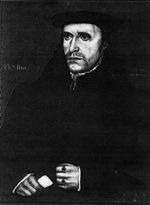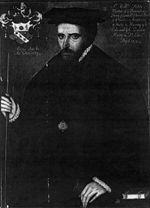
|
Portraits of William Petre The role of a personality - Sir William Petre 'sprung from the willow rather than the oak,' - Portraits in Court Dress and Informally William Petre became one of the two Prinicipal Secretaries to King Henry VIII and a member of the Privy Council on or about 21 January 1544. Remarkably he was to serve in this capacity almost all of the Tudor line, that is Edward VI, then Mary Tudor and finally for a short while Elizabeth. A parvenu or 'new man', Sir William Petre, (he was knighted on taking office as Councillor and Secretary of State), personifies many of the significant trends of Tudor times. From humble origins in Devon, probably Tor Bryan, he had emerged in the service of Thomas Cromwell following degrees at Oxford University in both canon and civil law, (canon law was the law of the church). A Visitor of Monasteries he administered the closure of many religious houses for the king, but yet managed to win sufficient gratitude from the Papacy later to earn him in November 1555 a Papal Bull, (the word is derived from the lead seal or 'bulla), 'absolving him from every excommunication, suspension and interdict and other ecclesiastical censures and penalties for having acquired land which formerly belonged to the church.' The Portrait of 1567 shows Sir William Petre aged 61 years and wearing the trappings of high office, his 'uniform' if you will. He has a black gown trimmed with brown fur and, atop his head, he wears a black cap with ear flaps, (a necessity in early modern houses and palaces which were not so generously equipped as later dwellings with fire-places?). He carries the white willow-wand of office, (useful in the crowded corridors of power as an instrument to clear the way for royal business, as well as a symbol of authority?). Round his neck he has suspended on a ribbon the badge of the office of Chancellor of the Most Noble Order of the Garter - 'the Rose of gold inclosed with the garter'; this was the red and white Tudor rose and he was the first in this post to be ordained to wear this. The linen at his neck and wrists is 'ruffled'. The portrait of Sir William aged 40 years is less formal, yet it shows very carefully the rank of the sitter by means of the rings that he wears on his left hand. The ring on the fourth finger is the Secretary's Signet Seal with the Tudor rose. The impression of this would be affixed to important royal documents using beeswax. Apparently the other ring on his fore-finger was used less-frequently. In Sir William Petre's hand is a folded document, as befits a royal secretary and a courtier with such a strong legal background.9
|
||||||||
 |

